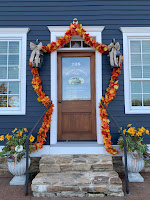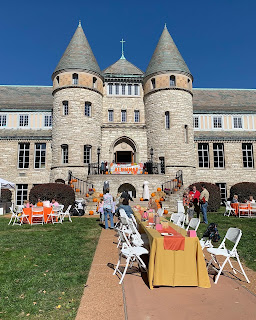My fondest memories of Big Cedar Lodge will be of doing nothing. Sitting in amicable silence on the porch with the people I love, rocking gently in the chairs and drinking in the fall colours. Or nodding off in communal peace in front of the fire, the scent of woodsmoke perfuming our cabin. But if that’s all you’re doing at Big Cedar you’re probably not getting your full value for money.
Part of that premium room rate is the exceptional range of activities and restaurants you can enjoy across the resort. Kayaks, canoes paddle boats, pools, beaches, putt putt and the fitness centre are all included. And, frankly, the whole place is so beautifully decorated and landscaped that simply walking around, pausing in picturesque spots and drinking it all in is an activity in itself. Our favourite outings added to the holiday’s bottom line … but I’d recommend all of these. In for the penny, in for the proverbial pound.
Lost Canyon Golf Cart Trail
If you do only one paid activity at Big Cedar, make it this. If you are anywhere in the area, make a detour to come here. This is a spectacular nature experience on par with any of America’s National Parks. OK, perhaps not the Grand Canyon. Put it’s pretty damned impressive.
Southern Missouri is rich in trees, limestone caves and springs, and this trail shows them all off to a ludicrously photogenic extreme. An early highlight is driving through a cave with a gushing waterfall in the back and many illuminated rock features. Suitably for this novel mode of rural transportation, there’s a drive-through bar on entry … the suitably named Bat Bar … so you can pick up canned beer or cocktails for your journey. The route continues over covered wooden bridges that cross gorges, along the side of ravines and through deep woodland. Waterfalls are spectacular and abundant, carving terraces and towers out of the limestone substrata while polishing the stone to a Carrara marble-like whiteness. Views stretch over vast miles where you see nothing but forest, even more beautiful when gilt by autumn colour. There’s even a viewpoint you can stop at and walk out onto an observation deck high above the valley floor. And though you only left the cave 20 minutes ago, there’s a mobile version of the Bat Bar here to top up your in-drive supplies.
The route is only 2.5 miles and in most countries would have been left to hikers. But this is the land of the automobile. And while the route shows off the best of nature, I suspect it’s not natural. Waterfalls have been helped along and the path determined for maximum impact. Keeping people to golf carts … even if you can pop out of them to explore, keeps people on track and limits the health and safety risks abundant in all those rocky inclines. It also makes the whole thing feel a lot more like a Disney attraction, which is helpful when justifying the approximately $40 per person to ride. That’s not per cart, but per rider. Yes, 4-person golf cart, $160. These people understand how to make money.
They also understand how to deliver value. There’s no time limit on cart rental. You could spin through the course in 30 minutes, or stop at every possible lay-by, do a bit of hiking and be out there for hours. (If I ever did it again I’d bring a picnic and art supplies.) The legal drinking and driving is inspired, giving a frisson of excitement without ever putting anyone in serious danger. Most impressive, from someone who’s starting to get old and creaky, is the accessibility. Nature’s greatest wonders are usually accessible only to those who are fit enough to hike to them. Or there are those few beside the road, so crammed with tourists you don’t feel you’re in nature at all. This is a brilliant compromise, crafted to feel like you’re in the deep wilderness but available to anyone who can climb into a golf cart.
Sunset at the Top of the Rock
The golf cart trail takes off from one end of the ridge called “Top of the Rock”. This is Johnny Morris’ culture and entertainment complex, part of Big Cedar Lodge but also open to the general public. Anyone can enter, but cars pay a $10 fee to do so, redeemable on food and drink bills. Residents skip this by taking resort transport. The main building here has several bars and restaurants plus a highly-acclaimed museum of local culture.Exhibitions include geology, fossils, modern wildlife and conservation and an excellent American Indian collection, all of which we sadly didn’t have time to consume this visit. We did manage to make it to one of the sprawling array of patios for the nightly sunset ceremony.
The view is spectacular and everything is built to make nature a stage with the setting sun at its centre. Copious fire pits keep people warm on cool nights. Outdoor sofas and benches allow lounging. One large area is reserved for diners at the Buffalo Bar. The resort has created a nightly ceremony featuring a Scots piper laying on a few tunes before a Civil War cannon fires a salute as the sun breeches the horizon. It’s a lovely bit of communal merriment.
The night we attended, however, it was also terribly staffed. Staffing was obviously a problem throughout our visit to the States but this was the night it was at its worst, with only two bartenders and one server looking after several hundred people. Over the course of 90 minutes we waited more than half an hour for each round of beer and wine. Service was further slowed because Americans order so many cocktails and every credit card order goes back to the customer for a tip. If there is any point at which a British visitor will feel superior, it’s here. American bartenders also seem to lack the British publican’s uncanny knack of knowing who’s next, instead allowing customers to sort themselves out. Rather than thinking fondly of your local publican and getting angry as you wait with people who don’t understand queueing, I recommend turning up for the ceremony with some cold canned beverages in your bag. If you do the golf cart tour just before, you can bring drinks from the Bat Bar.
Shooting School
It should be no surprise that a place dedicated to hunting, fishing and shooting should have rather spectacular facilities for the last. The resort’s gun club, officially the Bass Pro Shop’s Shooting Academy, looks like something drawn from Teddy Roosevelt’s fever dreams. From the shotguns that form the door handles at the main entry to the massive log walls and stone chimneys, antler chandeliers, bronzes of wild animals and exquisitely taxidermised specimens of everything in those woods that might be pursued and eaten, this place is a palace of hunting and conservation. (Those who do the first, of course, understand that the two go hand in hand, or the first would soon be impossible.) The building is clearly designed with group outings and special events in mind (max capacity 600); there are loads of rooms that can be arranged for different purposes, all with magnificent views.Like the Top of the Rock, which is about a 15 minute drive away, this complex is built on another ridge with another magnificent view.
Much like our local Spitfire Shoot, people without their own guns can buy into a package that includes guns, ammunition, safety briefing, instruction and time in the field shooting at clays. (Yes, European readers, contrary to your expectations Americans do not just let people pick up guns and have at it. The safety briefing and instruction is essential.) The shooting stands are built into the hillside below on terraces, with woodland as far as you can see spreading below. Rather amusingly, where any British shoot would have you walking the perhaps 200 metres, including some stairs, that’s a straight shot from building to the stands, Big Cedar loads everyone in golf carts and has you drive the long way round.
Our 1-hour package was $70. My only regret was that it was too short. Another half hour would have been perfect. Especially since our coach, Kennedy, wielded some sort of special magic. I have never shot better.
Dining
Unsurprisingly, Big Cedar majors on American classics. Burgers, steaks, ribs and other tasty slabs of grilled meat. I’m sure they’d find you something if you were vegetarian, but this is carnivorous country. I confess to disappointment that there wasn’t more game on the menu. Given the location and the ethos of the place, we figured every menu would feature venison, game birds and maybe rabbit. But our American friends told us that game is rarely eaten here outside the hunting community. And while there are plenty of hunters staying here, there are many more who are just enjoying the hunting lodge ambiance. Having critters on the menu just wouldn’t be viable.
While the restaurants vie to differentiate themselves, the outdoor theme and the core idea of American classics stretches across them all. I wouldn’t waste my money returning to the Lodge’s fine dining option, the Osage Restaurant, where the bison fillets were overdone, the every-element-is-a-la-cart philosophy drove up the bill and the vegetables had more char than flavour. (Our friends, it must be noted, said their steaks were fantastic.) This is the most spectacular of all the restaurants’ settings, however. If I had it to do over again, I’d book a table 40 minutes before sunset, enjoy the ceremony from there and order the cheapest stuff on the menu.
The Devil’s Pool Restaurant and the Buzzard Bar are in the same building, the former over the latter. Both overlook one of the resort’s prettiest swimming pools and are right next to a wildly picturesque waterfall and ravine crossed by a covered bridge. We ate in both and enjoyed both these meals more than the Osage, with particular praise going to the ribs. I had them in the Buzzard Bar but can’t really remember much difference between the two menus. The bar’s biggest differentiator is artist in residence Clay Self, who’s half singing cowboy and half stand up comedian. Self was a bit too local for my English husband who, between the performer’s accent, the cultural references he didn’t get and background noise wrecking havoc with his tinnitus, could comprehend little of what was going on.
While the rest of us enjoyed Self enormously, Mr. B was particularly happy to get back to the companionable silence of our cabin. We soon warmed that by a fire, blazing to almost instant life thanks to the well-seasoned firewood and kindling that comes with every cabin. Enjoy those Big Cedar activities, but leave plenty of quiet time to simply enjoy the place with the people you love.





































